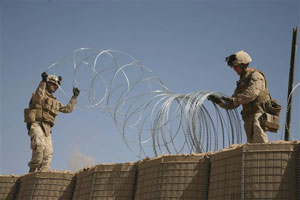| Home | Blog | Ask This | Showcase | Commentary | Comments | About Us | Contributors | Contact Us |

Digging in for the long haul in AfghanistanSHOWCASE | March 60, 2010Nick Turse answers questions about his recent finding that there are nearly 400 U.S. and coalition military bases in Afghanistan, what that says about our occupation and our military strategy, and the indirect and direct costs to the American taxpayers. It's a big story most Americans know nothing about. Nick Turse is the associate editor of TomDispatch.com, a fellow at New York University's Center for the United States and the Cold War, and author of The Complex: How the Military Invades Our Everyday Lives. He recently answered questions from the Nieman Watchdog Project. Q. In your latest piece for TomDispatch.com, you write that there are at present nearly 400 U.S. and coalition military bases in Afghanistan, and that the U.S. Government is in the process of spending some $3 billion in construction projects in the country. Why does this matter?
A. Where to begin? I think it matters because the United States is garrisoning a foreign land, on a massive scale -- but the American public has almost no idea of the size or scope of the project, the monies involved or the long-term commitment that these bases imply. I think it matters because occupations of this sort generally have horrific results for the occupied country and deleterious ones for the occupiers, as well.
I think it matters because the United States is still in a state of economic crisis and civilian infrastructure is in deep need of repair. Similarly, the people of Afghanistan are in even more dire need of infrastructure and money. Yet these funds are being put into building a greater capacity to carry out airstrikes and facilitate the occupation of a country that has, for centuries, fought long and hard against foreign occupiers. The strange thing is, until now we had no numbers on just how many bases the U.S. and its coalition partners had built there. I guess no one else bothered to ask. If this is the path the United States is taking, I think that Americans should have some idea about it.
Q. Four hundred bases does sound like an awful lot. And you write that in addition to those, there are some 300 Afghan National Army and Afghan National Police bases, most of them built, maintained, or supported by the U.S. What are these bases being used for, and what does it say about our military strategy that it is so construction-intensive?
The Pentagon’s bases are a key feature of the American way of warfare that you almost never see examined in any meaningful way in the mainstream media -- it’s what Chalmers Johnson has called the Empire of Bases. The U.S. military has, by its own count, close to 5,600 bases worldwide. Of these, more than 700 are located in foreign countries -- not counting the many hundreds in Afghanistan and Iraq and the “secret” bases in Qatar and elsewhere.
Q. You say these bases imply a long-term commitment. How long is long-term? How many if any of these bases are being built as “permanent” rather than “temporary” facilities, that can be taken apart and flown elsewhere, for instance? Should all this construction make us skeptical of the (admittedly vague) withdrawal timeline President Obama has been talking about? After all, some of the bigger projects presumably won’t even be complete for a while -- and the withdrawal is supposed to begin in mid-2011.
How long is long-term? That’s the $64,000 question -- or since we’re talking about the Pentagon, the $640 million dollar one. The U.S. military does not, as a rule, relinquish bases quickly or easily. Look at Germany, Italy and Japan. The war that spawned bases there ended many decades ago, but the garrisons are still going strong, with little prospect of the U.S. withdrawing from these countries in the future. Why is that? Because we need to prevent Italy from being swallowed up by a neighbor -- like Switzerland?
So, I think we have good reason to be skeptical of a true withdrawal anytime soon. When it comes to permanency, only a few of these are truly massive “enduring” bases like Bagram Air Base or Kandahar Airfield in Afghanistan, but exactly how many are just small combat outposts and forward operating bases is unclear. The numbers just aren’t available.
Q. Where’s the money for all this coming from? Is it part of the sacrosanct defense budget? The money that no political party will touch for fear of endangering our national security?
While few American taxpayers have any idea that there are now hundreds of military bases in Afghanistan, it’s all due to them -- to their dollars at least -- and is embedded in the ever-ballooning true national security budget (including, but not limited to Department of Defense spending) that now clocks in at around a $1 trillion per year -- and rising.
Q. Who is the money going to, to build all this stuff? Is it defense contractors, or is it construction companies? Or are they one and the same these days? Are they American companies, Afghan, or something else? Who’s getting rich on these projects?
There are three major defense contractors doing base-building work in Afghanistan: DynCorp International, Fluor and KBR. And then there are all sorts of local and regional contractors aiding the efforts. The companies involved are largely silent about what they’re up to and the military public affairs people involved with them are quieter still.
Q. A major reason for this spending, presumably, is that Afghanistan simply didn’t have the infrastructure to support a modern war effort. But are the facilities we are building exclusively for military use? Is any of it infrastructure that Afghans can take advantage of now? Will any of it at least be useful to them when and if we leave? (Although even if so, presumably, if it was up to them, they’d have other ways of spending that $3 billion.)
I think it might be advantageous to first stop and address what you term “a modern war effort.” It’s an excellent starting point for a debate Americans have never had and a place to begin discussion of issues never much confronted. I think the United States needs to grapple with the very notion of the “modern war effort” -- what it means, why the U.S. is so often implementing it, and why it is so regularly unsuccessful.
In this iteration of America’s modern war effort, in addition to hundreds of bases, we’re also talking about many tens of thousands of heavily armed and armored troops, advanced aircraft, heavy artillery, spy satellites, billions of dollars in weapons and gadgetry all arrayed against a rag-tag group of guerrillas in one of the most devastated nations on the planet. And it’s been dragging on for almost a decade. (This is, of course, part of a longer record of failure and futility: the Korea stalemate, the loss in Vietnam, crash and burn efforts in Cambodia and Laos, being chased from Lebanon and Somalia, failure to accomplish the mission in Iraq, etc.)
Quite obviously, there are real, fundamental problems. Given this, why haven’t Americans seen a comprehensive and wide-ranging network news investigation, a major many-part newspaper series, or a comprehensive special issue by a major news magazine that has plumbed the depths of why the United States gets into so many wars, why it fights them the way it does and why it does so poorly?
But I digress…
As to the contribution of base-building to Afghan infrastructure -- sure, the Afghans will likely be left with some more roads. How chewed up they’ll be when it’s all said and done is another issue. But I think the opening of my piece on those 700 bases gives the best example of the future that these bases portend. The “new” U.S./Afghan base in Shinwar is built on the crumbling rubble of a 19th century British base and involves the rehab of facilities that the Soviets built on the same site in the 1980s. If Afghanistan’s history is any guide, the future of American bases there looks rather dismal.
Q. There has been a great deal of reporting coming out of Afghanistan of late related to the offensive in Marja and surge-increased operations there. Has this improved the quality of the coverage in relation to the issue of bases?
I’m sorry to say it has not. And it isn’t due to a lack of reporters there. While nobody is going to visit 400 bases, one could survey a number of them and then analyze what they mean and what that says about the American way of warfare. The lack of deep reporting on the subject says something about the focus of media outlets with the financial means to send reporters to Afghanistan and their failure to grapple with big picture issues.
Take a recent piece about Marines in a Taliban "stronghold" near the southern city of Kandahar that appeared in the Wall Street Journal. (Which, I might add, has done some fine work in Afghanistan.) The reporter described a U.S. Army captain's problems in getting local Afghans to work on construction projects -- due to fear of Taliban retribution later. He wrote, "Yet, the only construction work here so far has been the hammering of U.S. Navy Seabees, or construction troops, erecting a vast American base overlooking Senjaray." References to many "vast American bases," as well as a sprinkling of "gee-whiz" pieces on fast-food franchise-filled mega-bases, have popped up in the press year after year. (The same was true of coverage of U.S. bases in Iraq.) But what you don’t see is deep, thoughtful analysis of the meaning of, the logic of, and the costs (financial and otherwise) of these "vast American bases", what messages they send to locals and what they say about the United States, writ large.
|
|||||||||


 From World War II onward, the U.S. military has been garrisoning the globe in a big way. And as it has begun fighting major wars without clear front lines, such as in Vietnam, Iraq and Afghanistan, it has relied on large numbers of bases -- from the big-box variety to smaller outposts and fire bases -- to facilitate its “big footprint”-style war-fighting efforts.
From World War II onward, the U.S. military has been garrisoning the globe in a big way. And as it has begun fighting major wars without clear front lines, such as in Vietnam, Iraq and Afghanistan, it has relied on large numbers of bases -- from the big-box variety to smaller outposts and fire bases -- to facilitate its “big footprint”-style war-fighting efforts.